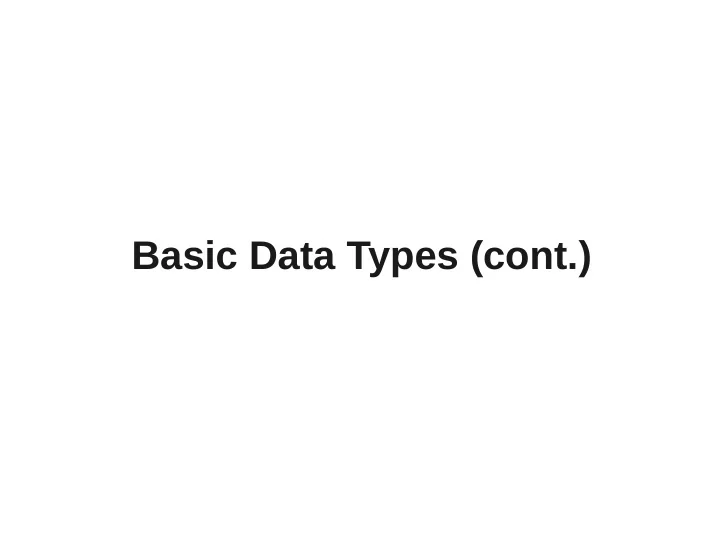

Basic Data Types (cont.)
Data Types in C Four Basic Data Types ● Char (1 Byte = 8 Bits) ● Int (4 Byte) ● Float (single precision – 4 Byte) ● Double (double precision – 8 Byte)
Type Modifiers ● Signedness – Unsigned: target type will have unsigned representation – Signed: target type will have signed representation (this is the default if omitted) ● Size – Short: target type will be optimized for space and will have width of at least 16 bits. – Long: target type will have width of at least 32 bits. – Long Long: target type will have width of at least 64 bits
Type Comparison
Char vs. Int ● char a = '1'; – Takes 1 byte in memory Stores byte “011 0001” – ASCII printable characters ●
Char vs. Int ● int a = 1; – Takes 4 bytes in memory – Stores 0000 0000 (first 3 bytes) – Stores 0000 0001 (as last byte) in memory – ● ASC II characters are also how we store a text file – Example: Hexdump
Unsigned vs. Signed (char, int) ● Unsigned char: 0~255 ● Signed char: -128~127
Two complement Arithmetic ● The most common method of representing signed integers on computers ● Unsigned ●
Two complement Arithmetic ● signed
C Integral Data Types
Overflow ● The max unsigned integer is 2^32-1 – If add two unsigned integer larger than 2^31, it will overflow, results will be mod by 2^32 ● The max signed integer is 2^31-1 – If add two signed integer larger than 2^31, it will overflow, results will be negative number
Unsigned Overflow
Signed Overflow
Float vs. Double ● Float (single precision 32 bits) ● Double precision (64 bits)
Why precision is import?
String in C ● C uses “array” of char as a string – String must ends with a special character '\0' ● char array2[] = { 'F', 'o', 'o', 'b', 'a', 'r', '\0' }; – Alternatively, you can define a string like ● char array2[] = “Foobar”; – Or using a char* “pointer” ● char *array2 = “Foobar”; – In both later ways, the NULL character is hidden
How to read and write ● Examples: (using printf and scanf)
How to read and write
Recommend
More recommend